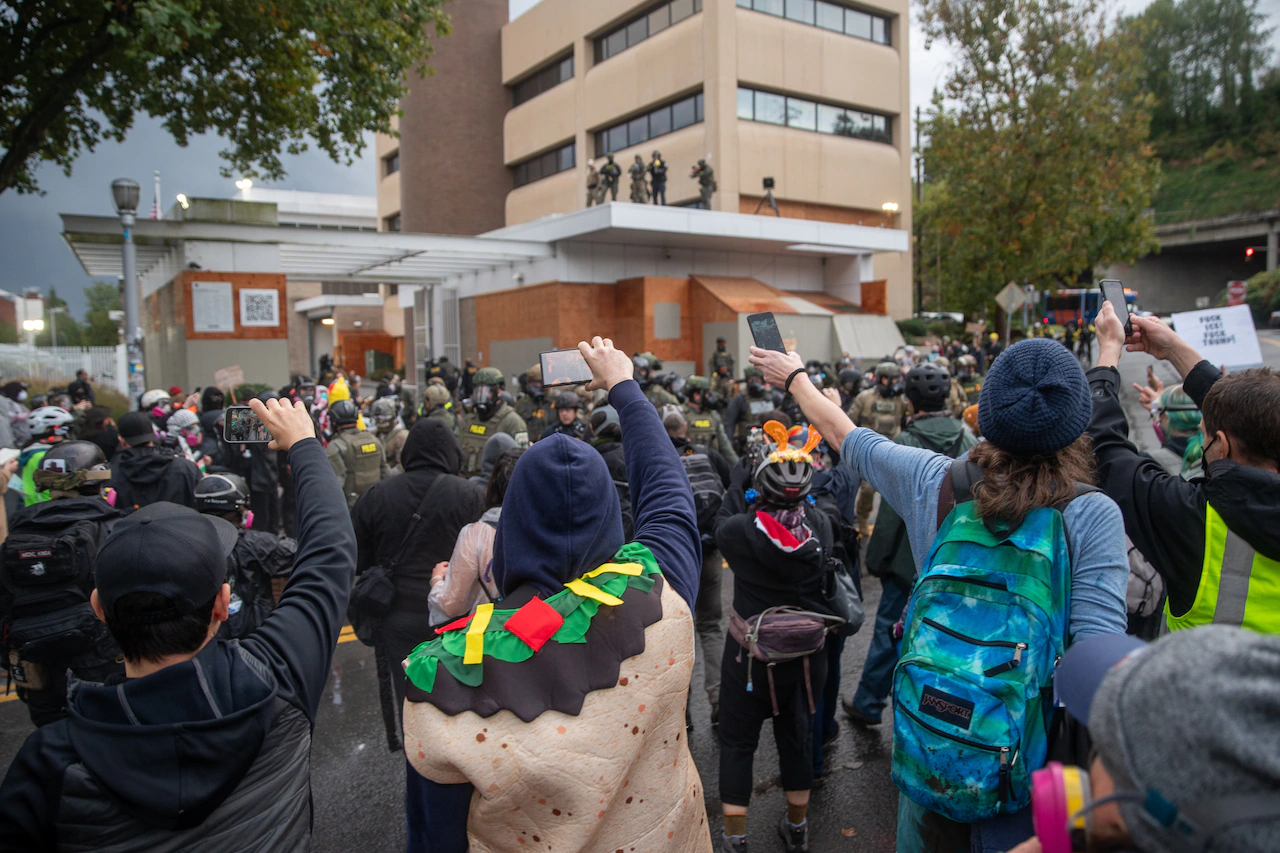Copyright The Oregonian

For the past several months, the Trump administration — along with conservative journalists and social media influencers — have repeatedly claimed Portland’s Immigration and Customs Enforcement building is under siege by “rioters” and that “riots” are a common occurrence at the site on the South Waterfront. But the facts don’t bear that out. The only time Portland police declared the scene in front of the ICE building in South Portland a riot this year was more than four months ago, on June 14, in what turned out to be a rare day of sustained violence. Angry people dressed in black stormed onto the property, used a stop sign post to shatter a glass door and threw water bottles and fireworks at federal officers. It was a fear-inducing scene, the likes of which have not been repeated. Instead, the overwhelming majority of protests have been peaceful, with others punctuated with low-level violence by a subset of the crowd, such as pushing and shoving. Local prosecutors have charged just two people with the crimes of “riot” in more than 140 days of demonstrations. And federal prosecutors haven’t charged anyone with that crime, according to a perusal of all charges that the U.S. Attorney’s Office for Oregon has filed against 37 defendants. That’s even though Trump administration officials they’re pursuing charges against those who attack federal officers to “the fullest extent of the law.” “We won’t sit idly by and watch these cowards,” read a June tweet by the U.S. Department of Homeland Security. Critics of the Trump administration have argued time and time again that Portland hasn’t been overtaken by mobs and the protests within the one or two blocks outside the ICE building are nothing like the civil unrest of 2020. That summer and fall, police declared riots at least 26 times, as many hundreds or even thousands of people protesting racial injustice and police violence demonstrated across Portland for more than 100 consecutive nights, Police in 2020 made at least 180 arrests for alleged rioting, though the newly elected district attorney at the time, Mike Schmidt, opted not to prosecute the vast majority of them, believing the justice system was too heavy handed. In the end, his office pursued riot charges against 42 people. (The number of federally charged defendants wasn’t available this week or last, in part due to the government shutdown.) On the U.S. Senate floor last week, Democratic U.S. Sen. Jeff Merkley of Oregon said President Donald Trump and his appointees have tried to paint the 2025 ICE protests as riots, especially after Trump announced in late September his intention to send in the National Guard. Merkley accused federal officers of staging a “fake riot” in mid-October, by firing flash-bang grenades and other repellants. “They threw down tear gas with big pluming smoke that was very irritating, and they fired pepper balls at the crowd,” Merkley said. “Well, the net result of that is the protesters scattered while being videographed so they would look — so that Trump’s team could say: ‘Look, there was a riot.’” Despite that riot characterization, Merkley told Senate colleagues that protesters have responded with peace, showing up with puppy dogs and in pajamas, eating pastries and dancing. “So far, the Portland protesters decided to engage in joy and whimsy,” Merkley said. “They have just frustrated the hell of the Trump team because they want riots.” Merkley is correct that many protesters have acted in that vein. He did not describe others who dress in black, cover their faces and yell vile insults at federal officers — not whimsical, but actions protected by the First Amendment, Portland police have pointed out. Federal law defines a riot as a “public disturbance” involving violence by at least one person who is part of a group of at least three people. Oregon law defines riot as “tumultuous and violent conduct” while part of a group of five or more people. The narrative of ongoing ‘riots’ The U.S. Department of Homeland Security didn’t respond to questions sent by The Oregonian/OregonLive last week or this week asking why DHS officials repeatedly referred to “riots” in their statements and social media posts, including a reference to as many as “250 rioters” on a single evening. The two people charged with rioting by the Multnomah County District Attorney’s Office don’t reflect widespread rioting. Instead, DHS offered only general statements describing violence inflicted upon federal officers nationwide. “Keep in mind that rioters and terrorists have opened fire on officers, thrown rocks, bottles, and fireworks at them, slashed the tires of their vehicles, and have destroyed multiple law enforcement vehicles,” the statement read. “Others have chosen to ignore commands and have attempted to impede law enforcement operations and used their vehicles as weapons against our officers.” The assertion that federal officers came under gunfire appears to refer to a gunman who opened fire at an ICE facility in Texas in September, killing two detainees and injuring another. No officers were hurt. The reference to use of “vehicles as weapons” appears to include a woman accused of ramming her car into federal agents in Chicago this month before they shot her. Federal officers at Portland’s ICE building haven’t been shot at or run into by cars, though a person carrying a knife pleaded guilty to intimidation of federal officers after swinging the knife in the air when stopped and another person has been charged with throwing a rock that struck a federal officer’s head. Why so few ‘riot’ declarations in Portland? Portland police say they address individual unlawful acts on a case-by-case basis instead of labeling an entire crowd as out of control. A spokesperson said most of that illegal behavior outside the ICE building has been between people with conflicting views on immigration or politics confronting each other. Police also say the decision to declare a riot “must meet a specific legal threshold and “is not done lightly.” “We recognize that there may be members of the crowd who are there to peacefully exercise their First Amendment rights, and if a riot is declared and people are told to disperse, it will impede that protected speech,” said police spokesperson Terri Wallo Strauss, responding via email to questions posed by The Oregonian/OregonLive. Specially trained “Crowd Management Incident Commanders” with the police bureau “have not declared more riots during these nightly events because they have not seen evidence that behavior is elevated to the threshold of a riot,” Wallo Strauss wrote. That approach held true in many cases in 2020, when Portland police declared riots on 26 of more than 100 nights of protests, despite numerous other instances in which small numbers of protesters shattered windows, broke into businesses, set fires or assaulted others. Police reserved the riot designation for gatherings with the widest spread mayhem, including mobs that repeatedly broke into or attempted to break into the federal courthouse or police buildings, threw Molotov cocktails and caused at least $2.5 million to downtown mall Pioneer Place. It’s unclear how many people federal prosecutors charged with “riot” in 2020 because the U.S. Attorney’s Office for Oregon didn’t respond to a request for information from The Oregonian/OregonLive. An automatic email reply said the office likely wouldn’t be able to reply during the federal shutdown. Though court records show federal prosecutors have charged no one with rioting outside the Portland ICE building in 2025, it’s unclear if federal officers sent them any possible cases for consideration because no federal authorities answered questions for this story. The Multnomah County District Attorney’s Office did answer questions about state charges. Spokesperson Pat Dooris told The Oregonian/OregonLive that local police forwarded four possible cases of defendants arrested under suspicion of rioting. Prosecutors decided to pursue other charges against two of the defendants — not rioting — and determined riot charges were appropriate in the other two cases, Dooris said. The defendants in those two cases are 24-year-old Austin Deever and 34-year-old Trenten Barker, Portland residents who are accused of splashing alcohol on a debris pile next to the gate at the ICE building on June 11 and then lighting it on fire. The pair also were charged with arson.



